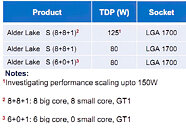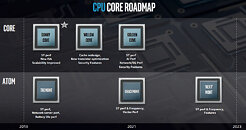
AMD Ryzen 8000 "Strix Point" APU Leak Points to 16 RDNA 3.5 CUs
PerformanceDatabases has uncovered details relating to an alleged engineering sample of AMD's Ryzen 8000 "Strix Point" APU—likely insider sourced CPU-Z screengrabs from early last month revealed that the upcoming Zen 5-based laptop chip (in their words): "is built on a 4 nm Process and features the Big.Little CPU architecture with 4 Performance Cores and 8 Efficiency Cores. Both the P and E-Cores support hyper-threading. On the P-Core and E-Core, the L1 Data cache is 48 KB, while the L1 instruction cache is 32 KB. Each P Core boasts 1 MB of cache, and with E-Cores, it looks like there are 4 in a group, sharing 1 MB of L2 Cache. This setup is quite similar to Intel's design. Keep in mind, it's still in the engineering sample (ES) stage, so there's more to come. We'll keep you posted on any further updates!"
Another "AMD Strix - Internal GPU" example emerged late last week, this time in the form of a leaked HWInfo64 screen grab with some information completely covered up—the visible parts seems to point to this "Strix Point" APU featuring a core configuration as seen in the earlier leak, along with 1024 unified shaders. We can presume that the sampled Zen 5-based mobile APU possessing 16 RDNA 3.5 compute units (16 × 64 = 1024). Other details include a 45 W TDP rating, and the socket type being FP8 (as utilized by current Ryzen 7040U and 7040H(S) mobile SoCs). The 512 MB GDDR6 memory configuration is very likely an error—according to HWInfo64, the tested system was fitted with 32 GB of LPDDR5 memory. "Strix Point" looks to be the logical successor (in 2024) to AMD's current "Phoenix" lineup of mobile processors, as featured in gaming handhelds and laptops. PC hardware enthusiasts are expressing excitement about the upcoming APU series wielding impressive iGPU performance, with the potential to rival modern discrete mobile solutions.
Another "AMD Strix - Internal GPU" example emerged late last week, this time in the form of a leaked HWInfo64 screen grab with some information completely covered up—the visible parts seems to point to this "Strix Point" APU featuring a core configuration as seen in the earlier leak, along with 1024 unified shaders. We can presume that the sampled Zen 5-based mobile APU possessing 16 RDNA 3.5 compute units (16 × 64 = 1024). Other details include a 45 W TDP rating, and the socket type being FP8 (as utilized by current Ryzen 7040U and 7040H(S) mobile SoCs). The 512 MB GDDR6 memory configuration is very likely an error—according to HWInfo64, the tested system was fitted with 32 GB of LPDDR5 memory. "Strix Point" looks to be the logical successor (in 2024) to AMD's current "Phoenix" lineup of mobile processors, as featured in gaming handhelds and laptops. PC hardware enthusiasts are expressing excitement about the upcoming APU series wielding impressive iGPU performance, with the potential to rival modern discrete mobile solutions.










